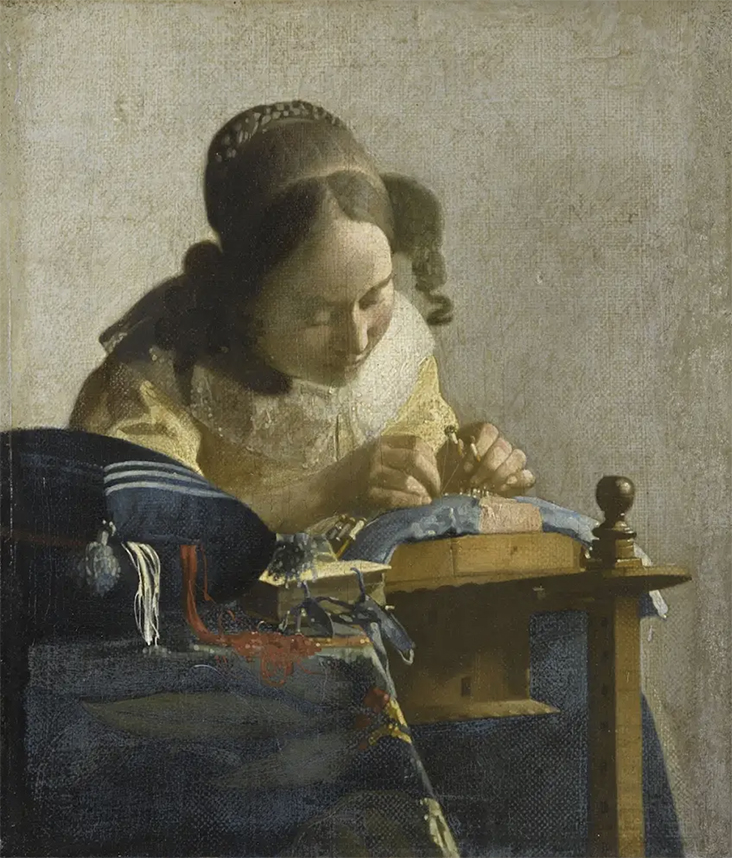Book Review: The Golden Thread: How Fabric Changed History by Kassia St Clair
Today, as we become more engaged with the things we use and wear, one of the joys of design are the many histories published on the subject. Design’s past has opened up before us experientially. Mining the cultural and technical elements which inform the things we collect in our homes and museums. In The Golden Thread: How fabric changed history; Kassia St Clair provides a wonderful example of how dynamic design history can be.
This is a book for design lovers and practitioners alike. As St Clair points out in the introduction: ‘Fabrics – man-made and natural – have changed, defined, advanced and shaped the world we live in.’ A central thread to the unfolding ‘stories’ (the chosen nomenclature for chapters) is how the role of social position, gender and race, are interwoven, if not instigated, in the histories of textiles. The book provides a history which illuminates how textiles spread across cultures: effecting (and reflecting) economics, politics and industry.
Although the book is rigorously referenced and researched; you are never left alone, abandoned in an academic cul-de-sac. St Clair always throws a safety line to allow you to relate history to the context of contemporary experience. In the introduction, for example, St Clair opens by recounting the Greek myth of the Fates. ‘Three mythological sisters who visited children soon after birth’. The sister Clotho, is the most powerful, she spun the threads of a person’s life, weaving an individual’s destiny. This mythology still influences how we see society today: the ‘social fabric’ of society, for instance, has never been so frayed or threadbare (some might argue) as it is today. But the story illustrates an important tenet of the book ‘Fabric, and its component parts have long been a figurative stand-in for the very stuff of life’
The book provides more than metaphorical connections to our past. In its thirteen stories you sweep from Viking boats to space exploration; smart materials to the impoverishment of slavery. You realise the importance of textiles and fashion to our identity and the ‘stuff of life’ when you read how slave owners in 18th Century America bought clothing for their slaves, in bulk, by weight rather than design or choice of fabric. Using cloth without pattern or design accept for, in some cases, stripes. Here you realise how design can be used as a form of erasure – non-identity.
In the chapter/story “Surf Dragons’ Viking culture is explored. The story tells of the Gokstad ship, now housed in Oslo, and built AD850. Although the textiles had largely vanished when the ship was excavated, the structure of the boat was intact. At 23m long ‘She has been called the most beautiful ship ever built, …: lithe, almost sculptural… the sweeping lines of the wooden planks … [are] surprisingly thin making the ship light and flexible’
The sails of the boat were discovered to be made of wool which, to a modern mind, seems counter-intuitive, but through forensic analysis you learn how the wool was sheared from a particularly breed of sheep, technically altered, preened and primed to capture the wind. Along with the story of the process of making the sails you learn about the Norwegian culture in a myriad of ways – from its pottery to weaving, how industry and production was influenced by the seasons and gender (spinning, weaving and the finishing of the sails was woman’s work.) The Vikings attention to the materials available to them, the rhythm of the seasons, can be easily transposed to Scandinavian Modernist designers in the 20th Century like Arne Jacobsen and Nanny Still.
In the story a “Kings Ransom’ you see the continued importance of wool in Medieval Europe. In England wool is part of the clothing worn by Robin Hood. Like all the stories which structure the book; you learn more than the development of wool. The author’s narrative style is to embed the textile within the broader context of the time – she enlivens the stories with colour, smell and the gusto of the times investigated. Thus, we learn of the importance of colour, specifically green, in medieval times. How Robin Hood in a ballad of the time; is described as selling ‘grene cloth’ to Edward III, King of England. More broadly we learn how social class and standing are formally attached to fashion and textiles in medieval Britain. Taxes (and tariffs) made it impossible for most inhabitants to wear silk or richly dyed textiles. Scarlet was only worn by the clergy and royalty, for instance. This use of textiles for social differentiation is still palpable today in how clothing is consumed: the handmade over machine made; manmade over natural materials. In many ways medieval society is very recognisable today in our economic landscape of Brexit, Trump tariffs, and trade wars. In ‘Workers in The Factory’ the 10th story she follows the advance of textiles and manmade fabrics like Rayon, developments which eventually lead to environmental impact of fast- fashion today.
The concluding stories look at the current uses of material in space and in athletics. In Under Pressure; Suits suitable for space, not only do you learn the technical developments in textiles, but the more pragmatic descriptions of putting a space suit on for Apollo 11, in 1969. Neil Armstrong on his walk on the moon ‘ …could hear little except the sounds his spacesuit made: the hum of pumps, the rustle of fabric and the tinny voices of Mission Control.’ It is these insights, and sonic evocations, which bring warmth to the book.

Apollo 11 backup crewmembers Haise (left) and Lovell about to enter the Lunar Module for an altitude test via NASA
Books like The Golden Thread allow us to witness how cultures in design are influenced by nature and environment; politics and economics, and not fashion trends and taste alone. And finally, how the everydayness of textiles captures our past, and influences how we interact with the world we live in. In the book’s coda St Clair writes: ‘Golden textiles – and the stories we tell ourselves and each other about them – are at the most exclusive apex of a rich, global tradition.’
Kassia St Clair provides 13 intriguing stories to enrich this tradition.
‘The Golden Thread: How Fabric Changed History’ was a BBC Radio 4 Book of the Week, a Sunday Times Book of the Year and was shortlisted for the Somerset Maugham Award.
‘The Golden Thread’ is out now in the UK, published by John Murray. It is published in America by Liveright and is being translated into multiple languages, including Dutch, Chinese and German.
[Please note this post contains affiliate links and we may earn a commission if you make a purchase.]








































6 Comments
Elaine Rutledge
Thanks for a great review! I’ve ordered the book and look forward to the adventure.
Colin D
Thank you. I hope you enjoy the book. It is a great read.
Colleen Laughton
Hello Colin,
Wonderful review of The Golden Thread – it’s definitely going on my Christmas Wish List.
Thanks
Colleen L
Colin D
Thank you for the encouraging feedback. I love books which open up history for us.
Laura Overturf
Dear Colin,
I enjoyed your great review of St Clair’s book, The Golden Thread. Can’t wait to read it….thank you,
Laura O.
Colin D
Thank you for your positive feedback. It’s a great book.